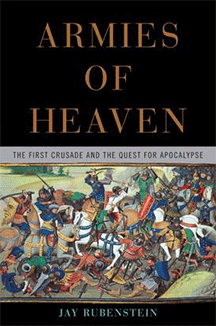By Fred H. Lawson
In November 1095, Pope Urban the Second called on Christians in the West to embark on a large-scale military campaign to liberate Jerusalem from its Muslim overlords. His call coincided with the preaching of Peter the Hermit, who was traveling across northern France and Germany telling anyone who would listen about the horrors that were routinely inflicted on Christian pilgrims who visited the Holy Land. Mobilized to action by these overlapping appeals, a hundred thousand men, women, and children set off to accomplish God’s will by engaging in a new form of religiously-sanctioned warfare—a Crusade—against an assortment of Easterners, variously called Saracens, Turks, Egyptians, and Muslims.
Several recent books tell the story of the First Crusade, most notably Jonathan Riley-Smith’s The First Crusade and the Idea of Crusading (University of Pennsylvania Press, 1986) and The First Crusaders (Cambridge University Press, 1997), John France’s Victory in the East (Cambridge University Press, 1994) and Thomas Asbridge’s The First Crusade (Oxford University Press, 2004). Jay Rubenstein proposes to add to existing scholarly accounts by painting a truer picture of the motivations and atmosphere that permeated the movement. In particular, he asserts that the First Crusade was driven by widely-held notions of the Apocalypse, that is, the expectation that the world as it existed was just about to come to a cataclysmic end through Divine intervention.
This is a strong claim, and has the potential to displace debates about whether the Crusaders were motivated primarily by religious doctrine or instead by a desire for wealth and fame. If Rubenstein is right, such rationalist explanations need to be jettisoned in favor of an interpretation that emphasizes ecstatic behavior and sharp divergences between mental states and reality. One might even say, although Rubenstein does not do so, that the quest to construct a plausible rationale for the actions of the Crusaders reflects an inherently modern viewpoint that is out of keeping with the medieval European mindset. In other words, readers expect to see Norman Cohn’s classic study The Pursuit of the Millennium (Oxford University Press, 1957) extended to the case of the First Crusade.
No such project gets undertaken. The leaders of the movement are shown to adopt strategies that generally conform to the concrete circumstances at hand; diplomatic alliances with the rulers of Byzantium, Egypt, and Aleppo pretty much follow the hard-headed dictates of Realpolitik; and important figures pull out of the campaign whenever events on the ground start to look hopeless. In other words, the text by and large presents the protagonists as rational actors. Rubenstein adds a variety of anecdotes about visions and other miraculous occurrences at key moments, but it is hard to tell to what extent such vignettes reflect the interpretations and interests of the later chroniclers upon whose writings the book relies. It is striking that at no point do any of the Crusader leaders express the opinion that the world is about to end, or take a decision that is rooted in that belief. Nor is there any evidence that Crusader commanders expected their actions to bring about the Millennium, despite Rubenstein’s occasional hints that they may have had Christ’s thousand-year reign on Earth somehow in mind.
Despite acknowledging Francesco Gabrieli’s Arab Historians of the Crusades (University of California Press, 1984) and Carole Hillenbrand’s The Crusades: Islamic Perspectives (Edinburgh University Press, 1999), Rubenstein offers a quite old-fashioned view of the Crusaders’ foes. The names of persons and places appear much as they do in the early chronicles, rather than according to current practice. Non-specialists may find it hard to remember that the terms Egyptians and Fatimids refer to the same people, and the author neglects to warn readers that Babylon in this instance denotes the capital of Egypt. A little additional research on relations among the Seljuqs, Fatimids, and Atabegs of Mosul and Aleppo might have helped the book draw a clearer picture of the complex political arena into which the Crusaders ventured.
Almost in passing, Rubenstein notes that by the late tenth century a popular legend had grown up in Europe that “during the Last Days a Christian leader, sometimes called the Last World Emperor, would unite his people in the Eastern and Western worlds before going to Jerusalem to wear his crown.” This component of medieval apocalyptic thought goes unmentioned in the remainder of the text, only to re-emerge in the title of the second-to-last chapter on Jerusalem under Crusader rule. The body of that chapter recounts the struggle among Godfrey of Bouillon, Raymond of Saint-Gilles, and Tancred, the nephew of Bohemond, for control over the city. At no point is the legend said to have played a role in the contest. Raymond of Aguilers argues against crowning a king at all, not on the grounds that this would usher in the End Time but rather because having a monarch in Jerusalem would dishonor Christ; Godfrey of Bouillon concurs, despite agreeing to accept the title. One wonders whether the legend of the Last World Emperor could provide the basis for an interpretation of the origins and trajectory of the First Crusade that is more tightly focused than Rubenstein’s repeated assertion that things were broadly apocalyptic in nature. Perhaps it was this intriguing myth that convinced so many powerful princes to embark on the campaign in the first place, and then sparked such intense rivalry among them.
Fred H. Lawson (ΦBK, Indiana University, 1973) is the Lynn T. White, Jr. Professor of Government at Mills College and a resident member of the Zeta of California Chapter of Phi Beta Kappa.




